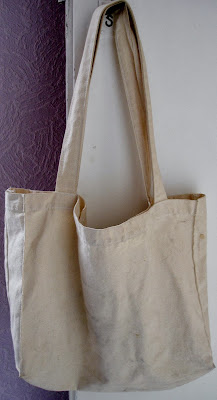In the spare bedroom I have a small pile of clothing that need to go to the equivalent of goodwill here in France.
In that stack, left by someone who visited me well over a year ago, was a Chico blue turtle neck sweater in a size XL.
It had no
stains and was in very good condition. It was not really my color, I do not
look good in that shade of blue, but it was perfect for the challenge.
On line, I had taken,
or better put, watched the Craftsy class called Hand-Embellishing Knit Fabric:Stenciling, Appliqué, Beading and Embroidery. The class is taught by Natalie
Chanin of Alabama Chanin. The technique fascinates me. I bought her stitch
books, all 3 of them, and read them cover to cover. I had a good giggle over the
recipes. Some of the ingredients are difficult to obtain in France. My french friends found some of the recipes interesting as well. On my list soon is to try a couple recipes on them.
I pulled out some grey jersey I had in my stash and started to play making a small sample of the techniques taught in the Craftsy class.
Then there was the
announcement for the challenge at the beginning of summer. Always up for doing
something fun and creative, I joined.
I decided to make
the Corset from book 1.
In book 1, "Alabama Stitch Book: Projects and Stories Celebrating Hand-Sewing, Quilting and Embroidery for Contemporary Sustainable Style", re-use is stressed and the pattern and basic directions for taking an old knit tee-shirt and making something new with it are given.
In book 1, "Alabama Stitch Book: Projects and Stories Celebrating Hand-Sewing, Quilting and Embroidery for Contemporary Sustainable Style", re-use is stressed and the pattern and basic directions for taking an old knit tee-shirt and making something new with it are given.
In book 2,
"Alabama Studio Style: More Projects, Recipes & Stories Celebrating
Sustainable Fashion & Living", an interesting technique for appliqué
is given where the design is enlarged so that when it is appliquéd into place,
a wrinkled texture is obtained.
The blue shirt,
not really being my favorite shade of blue needed something to make the
appliqué stand out. I wanted to use the entire shirt (Where else would I find the same weight and texture fabric to go with the shirt?)
I decided to dye some of the shirt so that the appliqué could be made darker. In my stash I have a number of procion dyes in various colors and one of them was navy blue. Perfect for the look I was trying to obtain.
I decided to dye some of the shirt so that the appliqué could be made darker. In my stash I have a number of procion dyes in various colors and one of them was navy blue. Perfect for the look I was trying to obtain.
Everything that
was not used for the main pieces of the corset, all edge bindings and appliqué
were dyed a darkish shade of navy blue. The entire shirt is sewn by hand using
the recommended thread, Craft and Button 74% polyester, 26% cotton and uses the
method spelled out in the books and in the Craftsy class. Grey thread was used
for construction and beading rather than the blue thread since the blue thread
did not coordinate with the blue of the shirt.
Here is the final completed project:
Here is the final completed project:
 |
| Front |
 |
| Back |


































